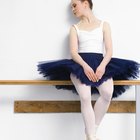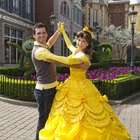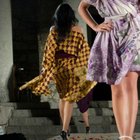Mexico’s colorful blend of European and Indian cultures is expressed in the traditional Mexican dance dress seen in the United States during a Folklorico festival. There is no one style, but many variations of color, skirt length and fullness.
Each of Mexico’s thirty-one states has its distinguishing cultural features represented in its dance costumes. The predominant styles come from Jalisco, Vera Cruz, Sinaloa and Yucatan. If you are interested in finding out more about various styles and costs for a mexican dress, go to mariachiconnection.com.
The most well-known style of Mexican dance dress in the United States is from Jalisco. This dress features a full, colorful skirt bordered with rows of ribbons (or similar trim) and topped with a ruffled yoke, trimmed with ribbons or rickrack to complement the skirt. The skirt is also distinctive for its width. A dancer can hold the ends of each side of the skirt and pull them up like a fan, enhancing the swirling and graceful moves, making the fabric a fluid part of the dance.
Steps to Making a Mexican Dance Dress
Determine the style of dress you want. Are you a member of a dance troupe, just learning Folklorico dance, or want a costume for Cinco de Mayo? The type of use and frequency of wear will determine how much of an investment of time and money you want to make in your dress. What style of dress is appropriate: a swirling dance dress from Jalisco or a highly embroidered skirt and blouse from Yucatan?
Assess your sewing skills. If you have experience constructing clothing and are not afraid to tackle a project using over twelve yards of fabric that requires precision application of dozens of yards of trim, then it may pay (in savings and satisfaction) to sew the dress yourself. You can find pattern sources online that carry Simplicity or Pattern Kingdom patterns. The sewing directions will be included in the pattern. Make sure you have plenty of workspace to accommodate the large pieces of fabric that make up the dress.
Choose the proper accessories. Before working on the dress, plan the type of accessories that are appropriate for the style you are sewing. If you are fortunate enough to have a Mexican community in your area, visit a dress shop or dressmaker. Many will specialize in making clothes for Folklorico dancers or Quinceanera parties (a traditional family celebration for a 15-year-old girl). Check the resource site for intricate combs, Mardi Gras–like glass bead necklaces called papillios, fans and dance shoes (think Mary Janes with square heels that you would see on a flamenco dancer).
Plan a month in advance. You will need that amount of time to find your pattern and material, construct the dress and locate accessories. But once you put it all together, you will have a beautiful and unique garment to dance in.
Related Articles

How to Make Irish Dancing Costumes

Sheath vs. Shift Dresses

How to Hem a Sequin Dress

How to Make Chaps Out of Pants

How to Dye a Silk Dress

How to Make a Tutu Stick Out

How to Make an Edge for a Bridal Veil

What Jacket to Wear With Satin Tube ...

How to Make a Fabric Poncho

How to Shorten the Shoulder Straps to a ...

How to Make a Homemade Disney Belle ...

How to Dye a Satin Dress

Hispanic Clothing History

What Does Couture Mean in the Fashion ...

What is a Gored Skirt?

How to Make a Bridal Cape for a Wedding ...

How to Make a Children's Folklorico ...

How to Decorate Your Denim Jeans With ...

How to Organize a Charity Fashion Show

How to Cut Up a Shirt for the Gym
References
Writer Bio
Frieda Cramer studied creative writing at Shoreline College and is pursuing a degree at the University of Washington. She served as editor of "Sprindrift" and has been published in "Spindrift," "Poets West," "Las Cruces," and the "National Paralegal Reporter." Cramer is a past board member of Washington Lawyers for the Arts.